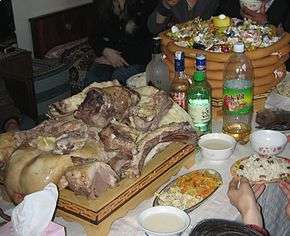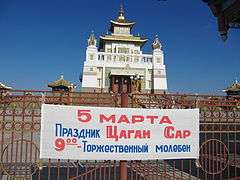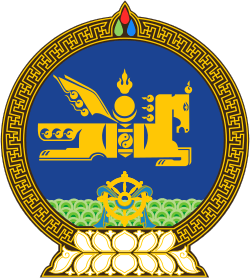Tsagaan Sar

The Mongolian Lunar New Year, commonly known as Tsagaan Sar (Mongolian: Цагаан сар, Cagán sar / ᠴᠠᠭᠠᠨ ᠰᠠᠷᠠ, Mongolian pronunciation: [t͡sʰaɢaːŋ sar] or literally White Moon)[note 1], is the first day of the year according to the Mongolian lunisolar calendar. The festival of the Lunar New Year is celebrated by the Mongols along with the people of the Arctic.
Timing
The White Moon festival is celebrated on the first through third days of the first lunar month. Tibet's Losar occurs on the same day as the Mongolian White Moon. Tsagaan Sar is one of the most important Mongolian holidays.[1]
Ceremony
The customs of Tsagaan Sar are significantly different depending on the region. In Mongolia around the New Year for example, families burn candles at the altar symbolizing Buddhist enlightenment. Also people greet each other with holiday-specific greetings such as Амар байна уу? (Amar baina uu?), meaning "Are you living peacefully?"[2] Mongols also visit friends and family on this day and exchange gifts. A typical Mongol family will meet in the home dwelling of the eldest in the family.[3] Many people will be dressed in full garment of national Mongol costumes. When greeting their elders during the White Moon festival, Mongols perform the zolgokh greeting, grasping them by their elbows to show support for them. The eldest receives greetings from each member of the family except for his/her spouse.[3] During the greeting ceremony, family members hold long, typically blue, silk cloths called a khadag.[1] After the ceremony, the extended family eats sheep's tail, mutton, rice with curds, dairy products, and buuz. It is also typical to drink airag and exchange gifts.
The day before Tsagaan Sar is called Bituun, the name of the lunar phase of a new or dark moon. The lunar phases are Bituun (dark moon), Shined (new crescent moon), Tergel (full moon), and Huuchid (waxing moon). On the Bituun day, people thoroughly clean around home, herders also clean the livestock barns and shades, to meet the New Year fresh. The Bituun ceremony also includes burning candles to symbolize enlightenment of the samsara and all sentient beings and putting three pieces of ice at the doorway so that the horse of the deity Palden Lhamo could drink as the deity is believed to visit every household on this day. In the evening, families gather together—usually immediate family,[3] in contrast to the large feast gatherings of White Moon day — and see out the old year eating dairy products and buuz. Traditionally, Mongolians settle all issues and repay all debts from the old year by this day.[3]
Food
Depending on the region, food is prepared in a diverse array of forms. For example, the traditional food in Mongolia for the festival includes dairy products, rice with curds (tsagaa-цагаа) or rice with raisins (berees-бэрээс), a pyramid of traditional cookies erected on a large dish in a special fashion symbolising Mount Sumeru or Shambhala realm, a grilled side of sheep and minced beef or minced mutton steamed inside pastry, steamed dumplings known as buuz, horse meat and traditional cookies.[4] Tsagaan Sar is a lavish feast, requiring preparation days in advance, as the men and women make large quantities of buuz as a whole family, along with ul boov, a pastry reserved for both dessert and presentation.[3]
During communism
During Mongolia's Communist period, the government banned Tsagaan Sar and tried to replace it with a holiday called "Collective Herder's Day", but the holiday was practiced again after the 1990 Democratic Revolution in Mongolia.[5]
Dates
The Mongol calendar in the Tegus Buyantu (Төгсбуянт) system is a lunisolar calendar. The Tegus Buyantu astrology was developed by Mongol high priest Luvsandanzanjantsan (1639–1704), the first reincarnation of the Blama-yin Gegegen (Ламын гэгээн).[6] Tsagaan Sar is celebrated on the first through third days of the first lunar month.
| Gregorian year | Mongol year | Transliteration | Tsagaan Sar | Element and animal |
|---|---|---|---|---|
| 1989 | Цагаан | Tsagaan | 7 February – 10 February | female earth Snake |
| 1990 | Машид согтонги | Mashid sogtongi | 26 February – 28 February | male iron Horse |
| 1991 | Төрөлхтний эзэн | Törölkhtnii eeen | 15 February – 17 February | female iron Goat |
| 1992 | Ангира | Apgira | 4 February – 7 February | male water Monkey |
| 1993 | Цогт нигурт | Tsogt nigurt | 25 January – 30 January | female water Rooster |
| 1994 | Бода | Boda | 11 February – 13 February | male wooden Dog |
| 1995 | Насан төгөлдөр | Nasan tögöldör | 31 January – 5 February | female wooden Pig |
| 1996 | Баригч | Barigch | 19 February – 21 February | male fire Rat |
| 1997 | Эрхэт | Erkhet | 8 February – 10 February | female fire Ox |
| 1998 | Олон үрт | Olon ürt | 28 February – 2 March | male earth Tiger |
| 1999 | Согтох төгөлдөр | Sogtokh tögöldör | 17 February – 19 February | female earth Rabbit |
| 2000 | Тийн дарагч | Tiin daragch | 5 February – 8 February | male iron Dragon |
| 2001 | Сүргийн манлай | Sürgiin manlai | 24 January – 26 January | female iron Snake |
| 2002 | Элдэв | Eldev | 13 February – 15 February | male water Horse |
| 2003 | Наран | Naran | 2 February – 4 February | female water Goat |
| 2004 | Наран гэтэлгэгч | Naran getelgegch | 21 February – 23 February | male wood Monkey |
| 2005 | Газар тэтгэгч | Gazar tetgegch | 9 February – 11 February* | female wood Rooster |
| 2006 | Барагдашгүй | Baragdashgüi | 30 January – 1 February | male fire Dog |
| 2007 | Хамгийг номхотгогч | Khamgiig nomkhotgogch | 18 February – 20 February | female fire Pig |
| 2008 | Хотолыг баригч | Khotolyg barigch | 8 February – 10 February | male earth Rat |
| 2009 | Харшлалт | Kharshlalt | 25 February – 27 February | female earth Ox |
| 2010 | Тийн урвагч | Tiin urvagch | 14 February – 17 February | male iron Tiger |
| 2011 | Илжиг | Iljig | 3 February – 5 February | female iron Rabbit |
| 2012 | Баясгалан | Bayasgalan | 22 February – 25 February | male water Dragon |
| 2013 | Тийн ялагч | Tiin yalagch | 11 February – 13 February | female water Snake |
| 2014 | Ялгуусан | Yalguusan | 30 January – 1 February | male wood Horse |
| 2015 | Галзууруулагч | Galzuuruulagch | 19 February – 21 February | female wood Sheep |
| 2016 | Муу нүүрт | Muu nuurt | 9 February – 11 February | male fire Monkey |
| 2017 | Алтан унжлагат | Altan unjlagat | 27 February – 1 March | female fire Rooster |
| 2018 | Тийн унжлагат | Tiin unjlagat | 16 February – 18 February | male earth Dog |
See also
- List of Buddhist festivals
- Celebrations of Lunar New Year in other parts of Asia:
- Chinese New Year (Spring Festival)
- Korean New Year (Seollal)
- Japanese New Year (Shōgatsu)
- Tibetan New Year (Losar)
- Vietnamese New Year (Tết)
- Similar Asian Lunisolar New Year celebrations that occur in April:
- Burmese New Year (Thingyan)
- Cambodian New Year (Chaul Chnam Thmey)
- Lao New Year (Pii Mai)
- Sri Lankan New Year (Aluth Avuruddu)
- Thai New Year (Songkran)
Notes
- ↑ Russian Buryat: Сагаан һара, translit. Sagán ħara, IPA: [sagaːŋ ħara]; Oirat: Цаһан сар, translit. Cahan sar, IPA: [t͡saɣan sar]; Altay: Чага-Байрам; Sakha: Үрүнь Ый, translit. Ürüny ıy; Northern Sami: Vielgatguovssahasat; Inuktitut: ᐊᐳᑦᑕᖅᑭᖅ, translit. Aputtaqqiq; Greenlandic: Aputqaqortoq, Chinese: 查幹薩日; pinyin: Chágàn Sàrì, Xiao'erjing: ﭼَﺎقً ﺻَﺎژِ; Dungan: Санган сари, Sangan Sari
References
- 1 2 "Tsagan Sar: The Mongolian Lunar New Year". Mongoluls. 2007. March 13, 2008.Mongoluls.net
- ↑ Амар байна уу? (Are you rested/peaceful?)
- 1 2 3 4 5 "Tsagaan Sar, the Lunar New Year" Archived 2006-11-13 at the Wayback Machine.
- ↑ Kohn, Michael. Lonely Planet Mongolia. Lonely Planet, 2008, ISBN 978-1-74104-578-9, p. 44
- ↑ Marsh, Peter. The Horse-head Fiddle and the Cosmopolitan Reimagination of Tradition of Mongolia. Routledge, 2009, ISBN 978-0-415-97156-0, p. 136
- 1 2 Л. Тэрбиш. Монгол зурхайн цаг тооны бичиг

